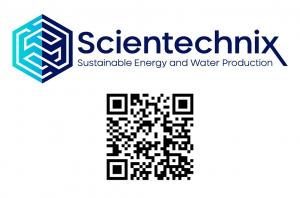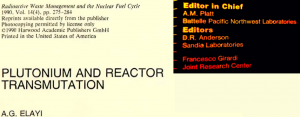Effective R&D management can turn these risks into opportunities, leading to major breakthroughs and successes that benefit both investors and society
PARIS, FRANCE, November 29, 2023 /EINPresswire.com/ -- I- When can the investment in R&D projects be catastrophic?To answer this question, we shall first consider 2 unquestionable examples with catastrophic investment results.
a) First example: 150 billion lost.
Nuclear fusion, as a technological and scientific quest, has often been compared to El Dorado research: a promise of an endless source of gold (or in this case, energy), but still elusive despite the massive resources devoted to it.
Since the 1950s, the history of nuclear fusion quest has been marked by many ambitious projects. The international ITER project, based in France, is probably the best known. Funded by a global consortium, it represents the largest collaborative effort in fusion research. The National Ignition Facility in the United States, the Joint European Torus in Europe, the JT-60 in Japan, and many others in Russia, China India… A rough estimate of the investment cost in the fusion technology gives 120 billion dollars at least.
This investment in nuclear fusion is a perfect example of how a poorly designed investment can lead to huge risks. Massive investment in nuclear fusion, without a clear strategy and a realistic assessment of the challenges, has left the world waiting for a promise made in 1950 that remains unfulfilled until today.
Of course, R&D for fusion is unquestionable. Two conclusions are however mandatory: 1) After 70 years it becomes obvious that there is a problem of strategy. 2) Investing large amount of money is far from being a guarantee of success.
Some of the investors in the nuclear fusion have lost large amounts of money because the goal has often been spurred by hopes rather than tangible technical realistic solutions. A thorough analyses and wise limited experiments would have shown how far we were from a realistic solution. Focusing on solving the real technical difficulties would have produced either a positive result or at least avoided useless investments.
b) Second example: The billion Cost of Institutional Deafness
1- Nuclear transmutation has long been touted as one of the most promising means to address the issue of radioactive waste. It involves converting long-lived radioactive elements into shorter-lived ones.
Despite billions in research and development investments in projects such as MYRRHA (Belgium), ADS (Spain), KALLA (Japan), TARC (États-Unis), FBR-MOX (Japan), FFTF (USA), VAK (Germany), ASTRID (France)… transmutation had still not demonstrated its industrial viability. . Today, all countries opt for burial as the radioactive waste management scenario.
2- Elayi's Document:
In 1990, nuclear physicist Alain Elayi published an article in the American journal "Radioactive Waste Management and the Nuclear Fuel Cycle". The scientific editors of this journal are from the National Security Laboratories in USA (See info box 1). In this article he thoroughly and precisely outlined the insurmountable technical, economic, and security challenges of transmutation.
His conclusions were backed by high-level calculations that were spanned over several years. He unambiguously concluded that it was impossible to achieve nuclear transmutation on an industrial scale.
3- The Huge Cost of Institutional Deafness: Billions Spent Despite Warnings: Regrettably, Elayi's article was not sufficiently heeded by decision-makers. Transmutation projects continued to receive massive funding, with most of them eventually being halted or delayed due to the challenges already identified by Elayi. The billions invested in transmutation projects could have been used elsewhere to address very high-priority needs.
In this case, Elayi’s demonstration make these investments even more inacceptable.
II- The Risks of Investment in Research and Development Projects and the Rewards
Investing in research and development (R&D) is crucial for innovation and economic progress. However, stakeholders must recognize that the R&D journey is fraught with uncertainties and risks that can threaten the return on investment and the viability of projects.
Firstly, technical risk is paramount. The feasibility of an R&D project is never guaranteed, and technical hurdles may prove insurmountable. Development costs can exceed forecasts, deadlines may be pushed back, and technology may turn out to be less effective than anticipated or become obsolete before even reaching the market.
Next, financial risk is also an element that cannot be ignored. R&D projects require substantial investments before generating any revenue. The investment cycles are long and the success rate is uncertain, making it difficult to predict the return on investment. Funding is often volatile and can be sensitive to economic fluctuations or changes in the policies of public or private institutions.
Commercial risk poses another challenge. Even if the technical development is successful, the innovative product or solution must find its market. Consumer behaviors, market conditions, and competition are dynamic and unpredictable factors that can affect the adoption and commercial success of an innovation.
The regulatory and legislative dimension also imposes its own set of risks. Strict standards in terms of safety, health, and the environment can delay or prevent the approval of new products. Moreover, changing legislation can impact the protection of patents and intellectual property rights, key elements for the profitability of R&D investments.
Finally, the risk associated with project management should not be underestimated. A lack of expertise, weaknesses in planning and coordination, or poor allocation of human and material resources can lead to failures in the management of R&D projects.
To mitigate these risks, investors must conduct rigorous and continuous project evaluation, adopt diversification strategies, and establish proactive technological and commercial monitoring. Effective R&D management can turn these risks into opportunities, leading to major breakthroughs and commercial successes that benefit both investors and society at large.
III- The case of desalination: massive investments following the wrong paths?
a) The Unavoidable Needs for Desalination
The United Nations and various global financial institutions recognize the escalating need for potable water. However, desalination requires energy and generates pollution.
Current R&D efforts in pollution-free desalination propose solutions with an exorbitant capital and operational expenditures, making large-scale applications financially untenable. Moreover, these efforts often give rise to additional problems, which themselves can necessitate further R&D for sustainable management. How risky are the investments needed to propose viable solutions in this field? Are they comparable to the fusion case, decades away from success or is the non-polluting, affordable technology for desalination about to succeed?
b) A Paradigm Shift in Desalination: The Zero-Investment Risk Approach
Scientechnix, a research and development company, declares to have assumed since 2013 the R&D development risks and proposes her nonpolluting desalination technology ready to be used. Led by Professor Doctor Alain Elayi, author of the 1990 article that worths billion’s dollars of saving in nuclear transmutation, Scientechnix now offers a technology that aligns with the urgent global mandate for international net-zero pollution strategies. This technology not only promises to revolutionize desalination but also comes with comprehensive assurances in technology, marketing, finance, intellectual property, resources, and environmental impact. Scientechnix's innovation provides the potential of achieving affordable, large-scale, pollution-free water production, a goal that remains elusive for all current R&D initiatives. It gives exceptional possibilities to develop international projects on the scale needed in 20024 and beyond. One of these projects is the green security belt proposed by Professor Alain Elayi
About Prof. Dr. Alain Elayi: Renowned Physicist, Professor Dr. Alain Elayi worked with major institutes and nuclear companies such as EDF and Electrabel. He invented a method to recycle a part of the 70 billion KWh of heat rejected each day into the environment. He developed MUDT in order to desalinate any quantity, anywhere, without pollution at a low cost for water production.
Personal website http://alain-elayi.com
About Scientechnix: Created in 1990 Scientechnix is a research company devoted to industrial applications. All the company’s income was devoted to research, making it a non-profit organization in all but in his name until the invention of its breakthrough for desalination, its last achievement. https://scientechnix.com
Professor Dr. Alain Elayi
Scientechnix
+33 1 85 54 00 92
Professor Dr Alain Elayi
Scientechnix
+33 1 85 54 00 92
email us here




